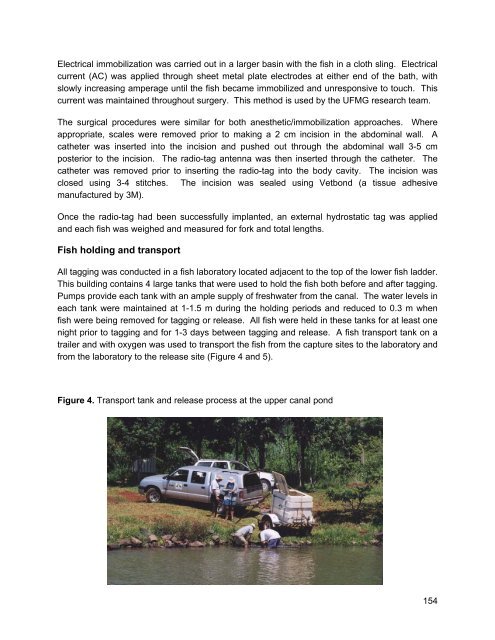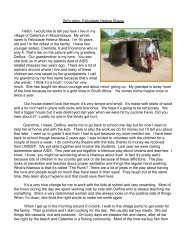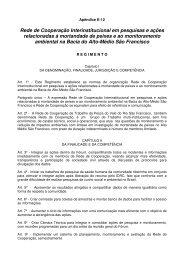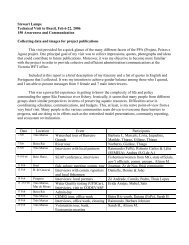- Page 1 and 2:
Semi-Annual Narrative Progress Repo
- Page 3 and 4:
Table of Contents Executive Summary
- Page 5 and 6:
Executive Summary The current semi-
- Page 7 and 8:
The percentage of project outputs a
- Page 9 and 10:
� Activity 3.2.2 - Canadian radio
- Page 11 and 12:
Horizonte on May 3 rd and included
- Page 13 and 14:
� Evolution of strategies for edu
- Page 15 and 16:
Project Spin-Offs The project has a
- Page 17 and 18:
� A proposed workshop on the Effe
- Page 19 and 20:
1) A multiplicity and diversity of
- Page 21 and 22:
Subproject/theme Completed During R
- Page 23 and 24:
Subproject/theme Completed During R
- Page 25 and 26:
Subproject/theme Component Location
- Page 27 and 28:
Subproject/theme Component Location
- Page 29 and 30:
TRIP REPORT Policing/Community Deve
- Page 31 and 32:
TRIP REPORT Prepared by: Joachim Ca
- Page 33 and 34:
� Hartland Rd. Landfill � CRD E
- Page 35 and 36:
VISIT HIGHLIGHTS CIDA Lessons Learn
- Page 37 and 38:
Native Friendship Centre, Victoria,
- Page 39 and 40:
� discussion on conflicts � dis
- Page 41 and 42:
Outcomes � appreciation of indivi
- Page 43 and 44:
� discussion of value of environm
- Page 45 and 46:
Participants � whole Brazilian te
- Page 47 and 48:
� hosted by Herb Redekop (DFO Low
- Page 49 and 50:
� participatory community researc
- Page 51 and 52:
Participants � whole Brazilian te
- Page 53 and 54:
Follow-up Calgary Police Service (N
- Page 55 and 56:
TRIP REPORT Prepared by: Barbara Jo
- Page 57 and 58:
� More widespread understanding t
- Page 59 and 60:
The Aquarium’s innovative publica
- Page 61 and 62:
As for recyclable/reusable material
- Page 63 and 64:
End: � responses are adequate;
- Page 65 and 66:
Education Program demonstrated by M
- Page 67 and 68:
Involve the community and science p
- Page 69 and 70:
Applications This type of council w
- Page 71 and 72:
November 2-Sunday November 3 - Powe
- Page 73 and 74:
Peixes, Pessoas e Água Proposal fo
- Page 75 and 76:
Tuesday, October 28 Technical visit
- Page 77 and 78:
Hugo P. Godinho May 6, 2004 76
- Page 79 and 80:
1. INTRODUCTION World Fisheries Tru
- Page 81 and 82:
VICTORIA - Headquarters of WFT > Vi
- Page 83 and 84:
NGO, a prize-winning pioneer in Can
- Page 85 and 86:
come up with solutions, working in
- Page 87 and 88:
Mike Miles and Associates, October
- Page 89 and 90:
TABLE OF CONTENTS Invitation ......
- Page 91 and 92:
QUESTIONNAIRE (translation Cathy Ca
- Page 93 and 94:
TRIP REPORT Prepared by: Joachim Ca
- Page 95 and 96:
meetings were very long and the UFS
- Page 97 and 98:
foreseen for the gender and race su
- Page 99 and 100:
UNIVERSIDADE FEDERAL DE SÃO CARLOS
- Page 101 and 102:
BLOCK A Characteristics of the Resi
- Page 103 and 104: APPENDIX - BLOCK B Municipality | _
- Page 105 and 106: 1 2 3 5 Given Name Terms of activit
- Page 107 and 108: (For the Head of the House and spou
- Page 109 and 110: TRIP REPORT 1 st State Aquaculture
- Page 111 and 112: PROGRAM 110
- Page 113 and 114: 112
- Page 115 and 116: INVITATION 114
- Page 117 and 118: PRESIDÊNCIA DA REPÚBLICA SECRETAR
- Page 119 and 120: 11 José Henrique Moreira Luisburgo
- Page 121 and 122: 51 Maria José Alves Costa Três Ma
- Page 123 and 124: Fernando Cláudio Dornelas São Jo
- Page 125 and 126: Joaquim de Carvalho Alfenas Col. Z
- Page 127 and 128: 21. Policing of feed-lots: Punish o
- Page 129 and 130: Almenara Colony Z- 13 Group 3: Summ
- Page 131 and 132: 3. Promote transfer of technology a
- Page 133 and 134: 9) Money for the fishery should be
- Page 135 and 136: MEETING REPORT Brazilian Associatio
- Page 137 and 138: DISCUSSION APSR opened the meeting,
- Page 139 and 140: MEETING REPORT Environmental Compon
- Page 141 and 142: INVITATION 140
- Page 143 and 144: � Increase public awareness about
- Page 145 and 146: Conference of Eight Cities of Três
- Page 147 and 148: TRIP REPORT Piracema Canal Technica
- Page 149 and 150: TRIP REPORT Prepared by: Karl Engli
- Page 151 and 152: Figure 1. Portion of the Itaipu Can
- Page 153: The tagged species represent a numb
- Page 157 and 158: At two of the stations, the receive
- Page 159 and 160: RESULTS Tagging and release A total
- Page 161 and 162: Table 3. Release dates and tracking
- Page 163 and 164: Gerais in 1999, put on by WFT, UFMG
- Page 165 and 166: and aircraft would also be useful t
- Page 167 and 168: Download and Detailed Check Procedu
- Page 169 and 170: � bad records could be the result
- Page 171 and 172: TRIP REPORT Prepared by: Luiz da Si
- Page 173 and 174: 4) Manual tracking Another activity
- Page 175 and 176: TECHNICAL REPORT Prepared by: Lisia
- Page 177 and 178: Figure 1. Piracema channel at Itaip
- Page 179 and 180: 2.6.3. Data management and processi
- Page 181 and 182: 4. REFERENCES ADAMS, N. S., RONDORF
- Page 183 and 184: JOURNAL ARTICLES Eco 21 #88 March 2
- Page 185 and 186: 184
- Page 187 and 188: Boletim SBI #74 March 2004 article:
- Page 189 and 190: 188
- Page 191 and 192: TRIP REPORT William Koski (LGL Envi
- Page 193 and 194: THESIS PROPOSAL Fish Migration Patt
- Page 195 and 196: INTRODUCTION For countless generati
- Page 197 and 198: The current state of knowledge of t
- Page 199 and 200: Specific goals � To describe the
- Page 201 and 202: The frequencies, channels and codes
- Page 203 and 204: SUB-PROJECT 2: EVALUATION OF THE CA
- Page 205 and 206:
Data Collection Data will be obtain
- Page 207 and 208:
REFERENCES ADAMS, N. S., RONDORF, D
- Page 209 and 210:
RESEARCH SUMMARY Genetic Analysis o
- Page 211 and 212:
The coast of BC has hundreds of sma
- Page 213 and 214:
mentioned earlier, the experience g
- Page 215 and 216:
Tropical freshwater commercial and
- Page 217 and 218:
Assessment techniques designed with
- Page 219 and 220:
may be no return? RAPFISH has been
- Page 221 and 222:
This diverse data begins to illustr
- Page 223 and 224:
REFERENCES CITED AND ADDITIONAL REA
- Page 225 and 226:
Gould, S.J. 2003. The Hedgehog, the
- Page 227 and 228:
Ruffino, M.L. 1995. Life cycles and
- Page 229 and 230:
PUBLIC PRESS ARTICLES Vancouver Aqu
- Page 231 and 232:
Canada and Brazil Join Forces on Ri
- Page 233 and 234:
INTRODUCTION Even though growing pu
- Page 235 and 236:
3) Ensure that the strategy is impl
- Page 237 and 238:
way, parents and other adults could
- Page 239 and 240:
Maps, Radio and Video Production of
- Page 241 and 242:
political agendas are saturated wit
- Page 243 and 244:
REFERENCES 1) Allen, William. 2001.
- Page 245 and 246:
APPENDIX G - MANAGEMENT RESULTS Tri
- Page 247 and 248:
TABLE OF CONTENTS Trip Report - pre
- Page 249 and 250:
Development, Governance, Gender Equ
- Page 251 and 252:
Name Organization Email Telephone M
- Page 253 and 254:
Name Organization Email Telephone M
- Page 255 and 256:
Name Organization Email Telephone C
- Page 257 and 258:
Cuidado Comunitário das Águas San
- Page 259 and 260:
ÍNDICE Sumário dos Formulários d
- Page 261 and 262:
SUMÁRIO DOS FORMULÁRIOS DE INSCRI
- Page 263 and 264:
Paz das Águas que ocorrem anualmen
- Page 265 and 266:
Inscrição Estadual: Endereço: Av
- Page 267 and 268:
1. APRESENTAÇÃO O projeto visa o
- Page 269 and 270:
3. ATIVIDADES ANTERIORES Federaçã
- Page 271 and 272:
Resultados Esperados Objetivo Espec
- Page 273 and 274:
6. METODOLOGIA EMPREGADA 6.1) Forta
- Page 275 and 276:
Abaeté, Pompéu e Três Marias com
- Page 277 and 278:
7. AVALIAÇÃO PROCESSUAL Objetivo
- Page 279 and 280:
8. AVALIAÇÃO DE RESULTADOS Objeti
- Page 281 and 282:
9. AVALIAÇÃO DE IMPACTOS Objetivo
- Page 283 and 284:
10. PARCERIAS E ALIANÇAS Organiza
- Page 285 and 286:
6 Melhorando o tratamento de esgoto
- Page 287 and 288:
1 2 3 4 5 6 7 8 9 10 11 12 Total To
- Page 289 and 290:
Petrobrás Contrapartida Total 13 1
- Page 291 and 292:
15. ANEXOS Currículo do Corpo Téc
- Page 293 and 294:
CURRICULUM VITAE: JOACHIM CAROLSFEL
- Page 295 and 296:
Fundação de Amparo à Pesquisa do
- Page 297 and 298:
CURRICULUM VITAE: NORBERTO SANTOS D
- Page 299 and 300:
TRIP REPORT Project Management and
- Page 301 and 302:
Mar. 1: CEMIG meeting on Funil; Sec
- Page 303 and 304:
� Need to look at all aspects and
- Page 305 and 306:
the processing plant, and Thiago To
- Page 307 and 308:
TRIP REPORT Project Management Miss
- Page 309 and 310:
ways that the results related to hi
- Page 311 and 312:
Appendix A - Results and Indicators
- Page 313 and 314:
Appendix C - Sub-project 1 Results
- Page 315 and 316:
Appendix E - Sub-project 3 Results
- Page 317:
Appendix G - Management Results 245





